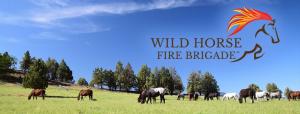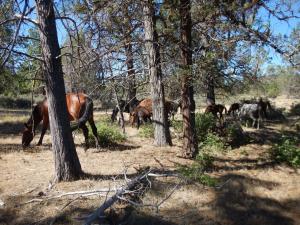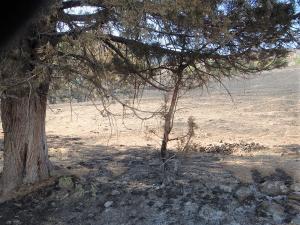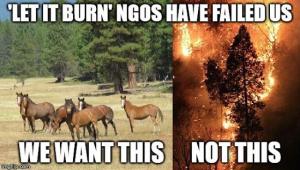
Wild Horse Fire Brigade is an all-volunteer CA-based 501-c-3 nonprofit organization whose mission is; Reducing catastrophic wildfire by saving American wild horses

Wild horses are symbiotic to forests. The photo shows a family of wild horses that is reducing wildfire fuels on the forest floor. Reduced wildfire fuels results in less heat produced during a wildfire.
California and Oregon’s collapsed herbivory combined with record precipitation predicts record growth of grass and brush fuels for 2023 wildfire season
YREKA, CA, US, January 13, 2023 /EINPresswire.com/ — Over the past 60 days of winter (2022-2023) western states of California and Oregon have seen well above normal precipitation, primarily in California, according to a report by Reuters.
Some rain and snowfall records are being broken with even more precipitation on it’s way according to forecasters.
While the drought-stricken western states welcome the gift of water, this record precipitation will generate massive amounts of grass and brush wildfire fuels across the western landscape.
It’s important to note that grass and brush are known by CALFIRE’s handbook as ‘1-hour class fuels’ and are the key fuels in more than 60% of all catastrophic wildfires according to a general survey of wildfire forensics published at the government wildfire reporting website InciWeb.
Precedent Causation of abnormally-high grass and brush fuel-loading across the landscape is the result of a serious decline in the populations of wild horses and deer in California and Oregon.
Given that grass and brush fuels are annually renewing, expensive and risky prescribed fire (aka; ‘controlled burning’, ‘cultural fire’, ‘eco-cultural fire’) would need to be applied frequently to the many millions of acres of landscape affected to manage these annual grass and brush fuels.
Of course this tail-chasing exercise ignores the precedent causation of prodigious grass and brush fuels, which is the collapsed herbivory in California.
In other words, California’s deer population has been decimated by mismanagement with an estimated decline of 2.5-million deer over the last 40-years.
In 2010, a report by SFGate stated that: “The California deer population has plummeted over the past two decades – by 46 percent”
According to the researched website ‘Deer Friendly’
“The state’s deer population has fallen from the peak of about 2 million around 1960 to around 460,000 in 2021. The graph at right shows an historical population estimate for California deer. See page 167 for details. The estimate is part of an effort to build a statistical model to help understand the reasons for the decline of the California population. This article provides evidence that reduced timber harvests and forest management, along with skewed deer demographics in California have contributed to the long term decline of the deer population. Although neighboring states have experienced somewhat similar declines, data indicate that no state in the West or in the rest of the United States has seen their deer population fall as much as California in the modern era.”
Other meta research by William E. Simpson II suggests that the reporting on the collapse of the deer populations in California and Oregon is suffering from latency in regard to calculating attributable losses of cervids (deer) due to catastrophic wildfires. And given that some estimates show between 20-80 animals (wildlife) are killed for each acre of wilderness burned by wildfire, the drop in the California deer population may be as much as 2.5-million deer. Data on Oregon’s deer populations suggest that the population of deer (mule deer and black tail deer) in Oregon is down about 500,000 deer over the past two decades.
Each deer that’s now missing from the forest had been consuming about 1.2-tons of grass and brush per year.
This means that the missing deer in California alone were cost-effectively and safely controlling/managing 2.4-million tons of annually-occurring grass and brush on the low-end (based-on 2-million deer missing), and 3-million tons of wildfire fuels on the high-end (based-on 2.5-million deer missing).
Filling the wildfire fuels grazing gap:
The ‘Natural Wildfire Abatement and Forest Protection Plan’, aka ‘Wild Horse Fire Brigade’ plan is virtually free of cost while being effective at safely maintaining grass and brush fuels year-round.
A PDF on ‘How and Why’ Wild Horse Fire Brigade Works: https://www.wildhorsefirebrigade.org/_files/ugd/b50928_b546b19ef08441349993b0d3fd8111eb.pdf
The ‘Wild Horse Fire Brigade’ plan can be implemented on a pilot scale in short order using wild horses than can be legally obtained by any government agency (city, town, county, state) from the Bureau of Land Management’s off-range holding corrals using the ‘Humane Transfer of Excess Animals ACT (H.R. 1625)’,
Wildfire grazing by wild horses provides measurable results, as seen in the Cascade Siskiyou National Monument during the 38,000-acre Klamathon Fire.
The winners from this natural and sustainable herbivory plan include:
1. Timber Industry – (trees are made fire-resilient by wild horses)
2. Forest and wildlife enthusiasts – (helps protect wilderness areas and wildlife)
3. Fisheries – (less post-wildfire erosion and debris flows)
4. Hunting Industry – (more natural prey species in the forest reduces depredation of cervids and livestock)
5. Livestock Industry – (more prey species in deep wilderness draws apex predators out of the WUI and livestock production areas)
6. Insurance Industry – (reduced frequency, size and intensity of wildfires results in reduced loss and casualties)
7. Climate Change/Crises – (reduced wildfires and need for prescribed fire reduces emissions of greenhouse gases ‘smoke’)
During the 2022 MUSTANG SUMMIT in Sacramento, William Simpson made presentation at the Guild Theater about Wildfire & Wild Horses (30-min. talk)
Watch that presentation (free) at YouTube: https://www.youtube.com/watch?v=s3pCv0VgMOI
3-min. Primer on ABC NEWS story about the Natural Wildfire Abatement and Forest Protection Plan:
https://www.youtube.com/watch?v=cFrLJ2vashU
Are Wild Horses a ‘Native Species’?
*Here’s what the world’s leading Equine Paleontologist (Dr. Ross MacPhee – Curator at the American Museum of Natural History) told the world at a transcribed lecture in New York: https://docs.google.com/document/d/1-zNiS1uqCWZ9PimwJpaVdY7NC57hxdGKDCLXbCEYb8c/
*The U.S. Ninth Circuit Court of Appeals in California recognized wild horses as native species, explaining that BLM “establishes Appropriate Management Levels (“AMLs”) for populations of native species – including wild horses, burros, and other wildlife – and introduced animals, such as livestock.” In Defense of Animals, et al. v. U.S. Dept. Interior, et al., No. 12-17804, *6 (9th Cir. May 12, 2014).
Wild Horse Fire Brigade Org (and link-minded supporters) believe that existing wild horse management is flawed and exorbitantly costly due to obsolete law from 1971 that predated consumer-driven land-use demands, and is based upon science from the 1960’s that is now clearly obsolete and that contradicts intelligent, updated wild horse management premises.
Further, Wild Horse Fire Brigade Org believes that it is no-good for wild horses and livestock to remain commingled in ecologically collapsed Herd Management Areas, many of which are virtually devoid of the natural predators of wild horses, and where wild horses are deemed to be in conflict with consumer-driven land-use demands.
And as such, horses should properly be humanely relocated to other more suitable wilderness areas where livestock production is illegal or impractical, where wild horses provide proven benefits to taxpayers and other stakeholders, and where they will not be in conflict with land-use demands; relocated to wilderness areas that are both economically and ecologically appropriate, ending the problem.
Here is a 2-minute YouTube video by Mike Schultz a leader in the livestock production industry: https://www.youtube.com/watch?v=tU5IjfXfcgQ
Putting fire onto 12-million acres of public lands in California as being proposed by some NGOs, is not only prohibitively expensive for taxpayers and required virtually on an annual basis, published science proves it’s wrong-headed and further damages the landscape and natural resources:
1. Prescribed/Controlled/Cultural Fires do not sequester carbon compounds into the soils as is the case with herbivores; and, sends more greenhouse gases into the atmosphere. EIN NEWS: https://www.einpresswire.com/article/606747655/eco-cultural-fire-rebranding-failed-prescribed-burning-as-wildfire-fuels-management
2. Low-severity wildfires impact soils more than previously believed – Negative effects of low-severity fire on soil structure and organic matter
Date: September 10, 2018
Source: Desert Research Institute
Summary:
“Low-severity wildland fires and prescribed burns have long been presumed by scientists and resource managers to be harmless to soils, but this may not be the case, new research shows. According to two new studies, low-severity burns cause damage to soil structure and organic matter in ways that are not immediately apparent after a fire.”
3. After The Fires – Hydrophobic Soils. University of Idaho : https://www.uidaho.edu/-/media/UIdaho-Responsive/Files/Extension/topic/forestry/F5-After-the-Fires-Hydrophobic-Soils.pdf
“Aside from property and aesthetic loss, this can include situations where highly erodible soils are exposed by burning the organic material on the soil surface. The burning of litter and organic material can reduce infiltration, increase surface runoff and erosion, and lead to hydrophobicity, or hydrophobic soils.”
4) Importance of maintaining cover crops in wilderness for ground water during drought. PLOS:
Comparing infiltration rates in soils managed with conventional and alternative farming methods: A meta-analysis
“We found that introducing perennials (grasses, agroforestry, managed forestry) or cover crops led to the largest increases in infiltration rates (mean responses of 59.2 ± 20.9% and 34.8 ± 7.7%, respectively). Also, although the overall effect of no-till was non-significant (5.7 ± 9.7%), the practice led to increases in wetter climates and when combined with residue retention.”
Ethologist William E. Simpson’s 8-years of studying how wild horses engage in carbon-cycling into soils while concurrently reseeding soils with the undigested seeds of native flora via their dung is opening-up new options for managing wildfire fuels as well as managing wild horses.
The reseeding of native plants function performed by wild horses is not seen in ruminants that digests virtually all of the native flora seeds they consume. It is a critically important fact that wild horses are exceptionally equipped to naturally manage wildfire fuel loading (grass and brush) by maintaining the grass and brush and preventing prodigious annual buildups. The reseeding of native species cover crops by wild horses is required for maximum infiltration of annual precipitation.
Further, reseeding of native flora by wild horses maintains the life-cycles of native flora required by co-evolved fauna that are dependent upon the native flora for their sustenance. The co-evolved fauna requiring proper native cover crops include big game animals (mammals and birds) as well as insects / pollinators.
It’s settled-science that ruminants (deer, cattle, sheep, goats) digest virtually all of the seeds they consume, and therefore, they end the life-cycles of plants and grasses that they use for forage (may be fine in areas where invasive species plants exist). Wild horses do not digest seeds like ruminants as is disclosed in several peer-reviewed published studies on the germinablity of seeds in horse dung.
Horse dung germinable seed content in relation to plant species abundance, diet composition and seed characteristics:
https://www.sciencedirect.com/science/article/abs/pii/S1439179104000866
The loss of native cover crops is disastrous for critical wilderness areas and leads to the degradation of forests and wildlife, since the net loss of native cover crops results in the decline of game animals (deer, elk, quail, grouse, chukar, pheasant, doves, etc.) (and non-game) and pollinators / insects.
The net loss of native cover crops in fire-stricken wilderness (and areas subjected to prescribed/controlled/cultural burns) also leads to catastrophic erosion and debris-flows, which costs American taxpayers hundreds of $-millions annually.
The post fire erosion is devastating on fisheries as a result of sedimentaton of spawning beds for endangered salmonids and trout, and results in collapsed fisheries.
KRISWEB – Sediment In Streams ; https://www.krisweb.com/stream/sediment.htm
“Excess sediment can profoundly effect the productivity of a salmon or trout stream (Cordone and Kelly, 1961). In a healthy stream, young salmon and trout hide in the interstitial spaces between cobbles and boulders to avoid predation . In streams that get extremely cold in winter, young steelhead may actually burrow into the streambed and spend the winter in flowing water down within the gravel. The area of the stream where flowing water extends down into the gravel is also extremely important for aquatic invertebrates, which supply most of the food for young salmon, steelhead and cutthroat trout. If fine sediment is clogging interstitial spaces between streambed gravel, juvenile salmonids lose their source of cover and food.
William E. Simpson II
Wild Horse Fire Brigade
+1 858-212-5762
email us here
Visit us on social media:
Facebook
Twitter
Instagram
YouTube
Other
More Wild Horses Equals Less Wildfire
![]()





